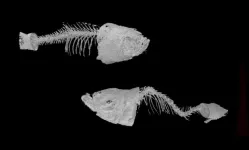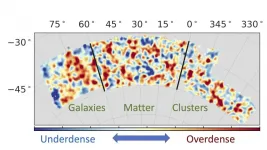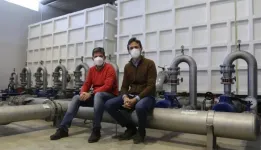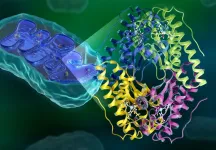New perspective to understand and treat a rare calcification disease
Researchers developed a new animal model to study a rare genetic disease that can lead to blindness at the age of 40-50.
2021-04-06
(Press-News.org) As part of an international collaboration, researchers from ELTE Eötvös Loránd University developed a new animal model to study a rare genetic disease that can lead to blindness at the age of 40-50. The new model could open up new perspectives in our understanding of this metabolic disease and will also help to identify new potential drug candidates, according to the recent study published in Frontiers in Cell and Developmental Biology.
Pseudoxanthoma elasticum (PXE) is a rare genetic disease with symptoms that usually manifest in adolescence or in early adulthood. The symptoms are caused by the appearance of hydroxyapatite crystal deposits in the subcutaneous connective tissue and retina and later can also appear in the vascular system. Excessive calcification in the retina can lead to blindness, while the crystals in the walls of the blood vessels result in the loss of their elasticity and in the development of severe vascular diseases.
The researchers of the DanioLab Research Group at the Department of Genetics of the ELTE Eötvös Loránd University, supported by the Diagnostics and Therapy Excellence Program, collaborated with researchers from the ELKH-RCNS Institute of Enzymology, Semmelweis University Institute of Physiology, and the US National Human Genome Research Institute (NHGRI) to create a new model for PXE. The researcher used zebrafish (Danio rerio), a popular model of genetic research, to gain a better understanding of this rare genetic disease.
Why is zebrafish a good animal model?
PXE usually develops in patients carrying mutations in the ABCC6 gene, encoding a cell membrane transporter protein. The zebrafish genome harbors three variants (so-called paralogues) of this gene: abcc6a is located on chromosome 6, while abcc6b.1 and abcc6b.2 are located on chromosome 3. Closer examination of the three paralogues, using new sequencing methods, revealed that only abcc6a and abcc6b.1 have a protein-coding function. In contrast, abcc6b.2 has lost its active role and is present as a pseudogene in the genome of the zebrafish.
The research team at ELTE Eötvös Loránd University successfully created and characterized mutant lines in the two protein-coding ABCC6 paralogues using the CRISPR/Cas9 genome-editing system, to understand if they have synergistic effects in the fish. "To our surprise, only abcc6a homozygous mutant animals showed defects in calcification. These could be observed relatively early, already at larval stages, indicating that loss of function of this gene in zebrafish affects calcification similarly to that seen in human patients. By adulthood, the skeletal system of the mutant animals was severely distorted. The spine is spectacularly twisted due to the excessive calcification between the vertebrae" - said Máté Varga, the head of the DanioLab Research Group at ELTE Eötvös Loránd University.
The new model will provide new opportunities for a better understanding of this metabolic disease and could become an important asset for future clinical research. The mutant lines created in the project will be used to test drug candidates with the potential to ameliorate PXE symptoms.
INFORMATION:
[Attachments] See images for this press release:

ELSE PRESS RELEASES FROM THIS DATE:
2021-04-06
The universe is expanding at an ever-increasing rate, and while no one is sure why, researchers with the Dark Energy Survey (DES) at least had a strategy for figuring it out: They would combine measurements of the distribution of matter, galaxies and galaxy clusters to better understand what's going on.
Reaching that goal turned out to be pretty tricky, but now a team led by researchers at the Department of Energy's SLAC National Accelerator Laboratory, Stanford University and the University of Arizona have come up with a solution. Their analysis, published April 6 in Physical Review ...
2021-04-06
Nursing mothers who receive a COVID-19 vaccine may pass protective antibodies to their babies through breast milk for at least 80 days following vaccination, suggests new research from Washington University School of Medicine in St. Louis.
"Our study showed a huge boost in antibodies against the COVID-19 virus in breast milk starting two weeks after the first shot, and this response was sustained for the course of our study, which was almost three months long," said first author Jeannie Kelly, MD, assistant professor of obstetrics and gynecology. "The antibodies levels were still high at the end of our study, so the protection likely extends even longer."
Based ...
2021-04-06
Cells from individuals with Major Depressive Disorder (MDD) were found to have higher than expected rates of methylation at specific sites on their DNA, when compared to cells from healthy individuals without MDD, according to a study by a multidisciplinary team of UC San Francisco scientists, in collaboration with others. Methylation is a process by which DNA is chemically modified at specific sites, resulting in changes in the expression of certain genes. Methylation of particular sets of genes, called "DNA methylation clocks," typically change in predictable ways as people ...
2021-04-06
During the early phase of the pandemic, approximately 40% of the COVID-19 literature was shared as preprints - freely available manuscripts that are shared prior to peer-review. In a new study publishing in the open access journal PLOS Biology, researchers led by Dr Jonathon Coates (Queen Mary University of London), Dr Nicholas Fraser (Leibniz Information Centre for Economics, Germany) and Dr Liam Brierley (University of Liverpool) explore the crucial role of preprint servers in hosting COVID-19 related science and how these preprints have been used to disseminate knowledge of COVID-19, leading to cultural shifts in journalistic and policy practices.
There has been a rapid and incredible scientific response to the COVID-19 pandemic, with research ...
2021-04-06
Innovation and advances in technology have facilitated agricultural activity in recent years, as traditional irrigation techniques have been supplanted by pressure-basedones, improving water efficiency but increasing energy dependence. This drives up the Agriculture sector's energy costs, some of the highest in the European Union.
With the aim of increasing the energy efficiency of irrigation, researchers at the Hydraulics and Irrigation Group with the María de Maeztu Unit of Excellence,at the Department of Agronomy of the University of Cordoba (DAUCO), Juan Antonio Rodríguez Díaz and Jorge García Morillo, have field-tested a low-cost technology that takes advantage of the excess pressure on the grid to generate energy. This ...
2021-04-06
It is difficult to imagine our daily life without lithium-ion batteries. They dominate the small format battery market for portable electronic devices, and are also commonly used in electric vehicles. At the same time, lithium-ion batteries have a number of serious issues, including: a potential fire hazard and performance loss at cold temperatures; as well as a considerable environmental impact of spent battery disposal.
According to the leader of the team of researchers, Professor in the Department of Electrochemistry at St Petersburg University END ...
2021-04-06
Ambient air pollution is a global public health crisis, causing more than 4.9 million premature deaths per year around the world. In Africa, it has surpassed AIDS as the leading cause of premature death. According to one study, air pollution--specifically, fine particulate matter (PM2.5)--may cause at least as many as 780,000 premature deaths annually in Africa and worsen a significant number of diseases, including asthma, lung cancer, and chronic obstructive pulmonary disease.
Kinshasa, capital of the Democratic Republic of the Congo, and Brazzaville, capital of the Republic of Congo, are both large metropolises. However, neither Kinshasa (population 14. 3 million) nor Brazzaville (population 2.4 million) have had comprehensive air quality monitoring programs. ...
2021-04-06
Scientists at UCL have used artificial intelligence (AI) to identify three new multiple sclerosis (MS) subtypes. Researchers say the groundbreaking findings will help identify those people more likely to have disease progression and help target treatments more effectively.
MS affects over 2.8 million people globally and 130,000 in the UK, and is classified into four* 'courses' (groups), which are defined as either relapsing or progressive. Patients are categorised by a mixture of clinical observations, assisted by MRI brain images, and patients' symptoms. These observations guide the timing and choice of treatment.
For this study, published in Nature Communications, researchers wanted to find out if there were any - as yet unidentified - patterns ...
2021-04-06
HOUSTON - (April 6, 2021) - Runoff from Houston's 2016 Tax Day flood and 2017's Hurricane Harvey flood carried human waste onto coral reefs more than 100 miles offshore in the Flower Garden Banks National Marine Sanctuary, according to a Rice University study.
"We were pretty shocked," said marine biologist Adrienne Correa, co-author of the study in Frontiers in Marine Science. "One thing we always thought the Flower Garden Banks were safe from was terrestrial runoff and nutrient pollution. It's a jolt to realize that in these extreme events, it's not just the salt marsh or the seagrass that we need to worry about. Offshore ecosystems can be affected too."
The Flower Garden Banks sit atop several salt domes near the edge ...
2021-04-06
Mitochondria, known as the powerhouses within human cells, generate the energy needed for cell survival. However, as a byproduct of this process, mitochondria also produce reactive oxygen species (ROS). At high enough concentrations, ROS cause oxidative damage and can even kill cells. An overabundance of ROS has been connected to various health issues, including cancers, neurological disorders, and heart disease.
An enzyme called manganese superoxide dismutase, or MnSOD, uses a mechanism involving electron and proton transfers to lower ROS levels in mitochondria, thus preventing oxidative damage and maintaining cell health. More than a quarter of known enzymes also rely on electron and proton transfers to facilitate cellular activities ...
LAST 30 PRESS RELEASES:
[Press-News.org] New perspective to understand and treat a rare calcification disease
Researchers developed a new animal model to study a rare genetic disease that can lead to blindness at the age of 40-50.







